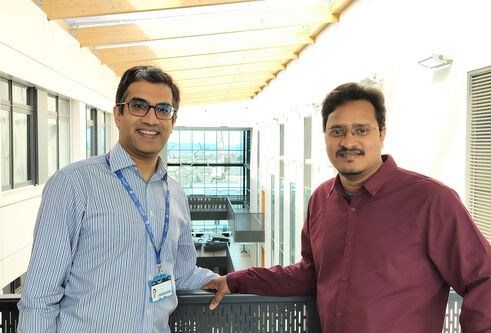Contact
Biography
Raja obtained his Ph.D. degree from Institute of Bioinformatics, Bangalore, India. He spent four years during his Ph.D. in the laboratories of Prof. Akhilesh Pandey and Prof. Richard Huganir at Johns Hopkins University School of Medicine, Baltimore, USA. He gained an incredible experience in handling several generations of Orbitrap mass spectrometers, liquid chromatography and contributed to the draft map of human proteome He also used SILAC mouse model to study protein turnover in synaptosomes using high resolution mass spectrometry.
Raja joined the laboratory of Prof. Dario Alessi for his Postdoctoral studies in March 2017. He contributed to the identification of endogenous phospho RAB proteins as bonafide substrates of Parkinson’s disease linked kinase, Leucine rich repeat kinase 2 (LRRK2), and developed a sensitive multiplexed targeted mass spectrometry assay to monitor the LRRK2 kinase activity and phospho RAB proteins absolute amounts in PD mice models and VPS35 D620N patient derived neutrophils. In addition, he optimized phosphoproteomics workflows using TMT-based multiplexing strategies to identify the substrates of SGK3, LRRK1, NUAK1, NUAK2 and WNK kinases. Over the past three years, he has been part of Aligning Science Across Parkinson’s (ASAP) initiative and employed ultra-sensitive data independent acquisitions mass spectrometry methods to study the Organelle proteomes such as Golgi, Lysosomes and mitochondria.
In 2024, Raja started as an Independent Investigator in MRC PPU, University of Dundee to study motor neuron disease in close collaboration with Prof. Siddharthan Chandran lab at UK-DRI Edinburgh, University of Edinburgh.
Research
Motor neuron disease (MND) is a rapidly progressive disease affecting upper and lower motor neurons with a lifetime risk of 1 in 300 and a median survival rate of 2-3 years. While genome wide association studies for most common neurodegenerative diseases (ND) have pinpointed the risk alleles that cause familial Parkinson’s, Alzheimer’s, and motor neurone disease. However, several of these diseases appear to arise due to sporadic mutations as well, thus a better understanding and dissecting the signalling pathways would be the major focus in developing personalised therapeutic strategies in treating these devastating diseases. Most ND do share commonalities in their signalling and associated disease co-pathologies, for example, loss of function and aggregation seen in >97% ALS, 30 to 50% in FTD and AD patients suggesting a commonality at the level of molecular and signalling contributing to the disease progression. Recent research undertaken to study the role of glia, a vital immune and supporting cells of brain and specific population of neuronal cells such as Dopaminergic, cholinergic neurons within brain by global and single cell RNASeq. However, a thorough understanding of proteins that play a key function of a cell is inadequate, an un-biased mapping of proteomic and posttranslational modification (PTMs) profiles would aid in better understanding of the disease progression.
My research focus is to study and understand signalling pathways of motor neuron disease (MND) (aka, Amyotrophic lateral Sclerosis (ALS) with a precise interest to study TDP-43 and C9orf72 proteins. We are keen on developing a framework of quantitative proteomic methodologies to study the role of TDP-43 and C9orf72 loss of function (LoF) and gain of toxicity in MND. To tackle these research questions, our lab employs human induced-pluripotent stem cells (hiPSC) models, CRISPR-CAS9-based genome editing, biochemistry and state-of-the-art Ultra-sensitive mass spectrometry including single cell proteomic workflows and Bioinformatics. Additionally, we employ miniaturized proteomic methodologies to enrich post translational modifications such as protein phosphorylation and Ubiquitylation from sub-microgram (5 to 10µg) starting materials derived from cell/tissues including sub-cellular organelles.
Current research focus on 3 major areas includes but not limited to:
- Development of single cell and spatial proteomics methodologies to study motor neuron disease and other neurodegenerative diseases: The complexity and cellular heterogeneity of brain is being studied to understand the brain function, neurodegeneration and regeneration using RNASeq at single cell level. We aim to utilize and develop Ultra-sensitive mass spectrometry methodologies to define the proteomes at single cell resolution to study MND and other neurodegenerative disease.
- Investigate and study signalling pathways of TDP-43 and C9orf72 loss-of-function and gain of toxicity in motor neuron disease. We will employ Organelle proteomics (lysosome and mitochondria) and PTM (Phosphorylation and Ubiquitinome) enrichment methodologies on hiPSC motor neurons and glial cell models in studying cell signalling of TDP-43 and C9orf72 proteins in MND.
- Pinpointing changes in splicing mediated by TDP-43 Loss-of-function in clinical samples with a goal to develop blood-based biomarkers for motor neuron disease: TDP-43 functions to regulate splicing and RNA stability. Loss of function of TDP-43 often observed in familial as well as sporadic ALS results in aberrant splicing on plethora of genes leading to the generation of small non-functional cryptic exons/peptides. We are developing MS-based targeted parallel reaction monitoring assays to identify and quantify absolute amounts of cryptic peptides in blood (Peripheral macrophages, Plasma), CSF and in post-mortem derived brain samples. The developed assays will serve as diagnostic/prognostic biomarkers as well as clinical management of MND.

Workflow depicting the identification of TDP-43 mediated cryptic peptides in ALS and other neurodegenerative diseases.
Selected Publications
- Fasimoye, R., Dong, W., Nirujogi, R. S., Rawat, E. S., Iguchi, M., Nyame, K., Phung, T. K., Bagnoli, E., Prescott, A. R., Alessi, D. R., & Abu-Remaileh, M (2023) Golgi-IP, a tool for multimodal analysis of Golgi molecular content PNAS 120 doi:10.1073/pnas.2219953120 PMID: 37155866
- Phung TK*, Berndsen K, Shastry R, Phan TLCHB, Muqit MMK, Alessi DR*, Nirujogi RS* (2024) CURTAIN - A Unique Web-based tool for exploration and sharing of MS-based proteomics data PNAS 121 e2312676121 doi:10.1073/pnas.2312676121 PMID: 38324566
- Banerjee, P., Mehta, A.R., Nirujogi, R.S., Cooper, J., James, O.G., Nanda, J., Longden, J., Burr, K., Salzinger, A., Paza, E., Newton, J., Story, D., Pal, S., Smith, C., Alessi, D.R., Selvaraj, B.T., Priller, J., Chandran, S (2023) Cell-autonomous immune dysfunction driven by disrupted autophagy in C9orf72-ALS iPSC-derived microglia contributes to neurodegeneration Science Advances 9 EABQ0651 doi:10.1126/sciadv.abq0651 PMID: 37083530
- Nirujogi RS*, Tonelli F, Taylor M, Lis P, Zimprich A, Sammler E, Alessi DR*. (2021) Development of a multiplexed targeted mass spectrometry assay for LRRK2-phosphorylated Rabs and Ser910/Ser935 biomarker sites Biochemical Journal 478 299-326 doi:10.1042/BCJ20200930 PMID: 33367571
- Fan Y, Nirujogi RS, Garrido A, Ruiz-Martínez J, Bergareche-Yarza A, Mondragón-Rezola E, Vinagre-Aragón A, Croitoru I, Gorostidi Pagola A, Paternain Markinez L, Alcalay R, Hickman RA, Düring J, Gomes S, Pratuseviciute N, Padmanabhan S, Valldeoriola F, Pérez Sisqués L, Malagelada C, Ximelis T, Molina Porcel L, Martí MJ, Tolosa E, Alessi DR, Sammler EM (2021) R1441G but not G2019S mutation enhances LRRK2 mediated Rab10 phosphorylation in human peripheral blood neutrophils Acta Neuropathol doi:10.1007/s00401-021-02325-z PMID: 34125248
- Martin Steger, Federico Diez, Herschel S Dhekne, Pawel Lis, Raja S Nirujogi, Ozge Karayel, Francesca Tonelli, Terina N Martinez, Esben Lorentzen, Suzanne R Pfeffer, Dario R Alessi, Matthias Mann (2017) Systematic proteomic analysis of LRRK2-mediated Rab GTPase phosphorylation establishes a connection to ciliogenesis Elife 6 PMID: 29125462
- Malik, N, Nirujogi, RS, Peltier, J, Macartney, T, Wightman, M, Prescott, A, Gourlay, R, Trost, M, Alessi, D & Karapetsas, A (2019) Phosphoproteomics reveals that the hVPS34 regulated SGK3 kinase specifically phosphorylates endosomal proteins including Syntaxin-7, Syntaxin-12, RFIP4 and WDR44. Biochem J 476 3081-3107 PMID: 31665227
- Diering GH, Nirujogi RS, Roth RH, Worley PF, Pandey A, Huganir RL (2017) Homer1a drives homeostatic scaling-down of excitatory synapses during sleep Science 355 511-515 doi:10.1126/science.aai8355 PMID: 28154077
*Lead / Corresponding Author
Awards
| Award | Year |
|---|---|
| Innovator of the Year | 2022 |
Stories
News
Arpan Mehta and Raja Nirujogi, within months of being appointed as Independent Investigators at the MRC Protein Phosphorylation and Ubiquitylation Unit in the School, have each secured MND Accelerator (MNDAcc) Awards.

News
Dr Raja Nirujogi, who has been working in the MRC Protein Phosphorylation and Ubiquitylation Unit since 2017 has been appointed as an Independent Investigator within the School of Life Sciences.

News
Review of the Year 2021/2 took place last week with the Dean, Julian Blow sharing the highlights of activity within the School from 2022.